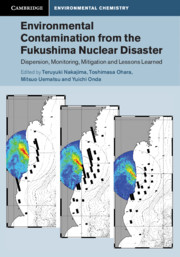 Environmental Contamination from the Fukushima Nuclear Disaster
Environmental Contamination from the Fukushima Nuclear Disaster Book contents
- Environmental Contamination from the Fukushima Nuclear Disaster
- Cambridge Environmental Chemistry Series
- Environmental Contamination from the Fukushima Nuclear Disaster
- Copyright page
- Contents
- Contributors
- Preface
- Acknowledgements
- Part I Transport of Radioactive Materials in the Environment
- Part II Development and Future Issues for the Infrastructure of Disaster Prevention
- Part III Lessons and Future Issues from the Fukushima Accident
- 10 Urgent Actions by Scientists
- 11 Emergency Actions and Messages Related to the Fukushima Accident
- 12 Recommendations for the Fukushima Project from Foreign Scientists
- Glossary
- Names of Locations
- Index
10 - Urgent Actions by Scientists
from Part III - Lessons and Future Issues from the Fukushima Accident
Published online by Cambridge University Press: 16 August 2019
- Environmental Contamination from the Fukushima Nuclear Disaster
- Cambridge Environmental Chemistry Series
- Environmental Contamination from the Fukushima Nuclear Disaster
- Copyright page
- Contents
- Contributors
- Preface
- Acknowledgements
- Part I Transport of Radioactive Materials in the Environment
- Part II Development and Future Issues for the Infrastructure of Disaster Prevention
- Part III Lessons and Future Issues from the Fukushima Accident
- 10 Urgent Actions by Scientists
- 11 Emergency Actions and Messages Related to the Fukushima Accident
- 12 Recommendations for the Fukushima Project from Foreign Scientists
- Glossary
- Names of Locations
- Index
Summary
The things we learned from the responses to the Fukushima Daiichi Nuclear Power Station (FDNPS) accident are as follows. (1) If experts had been properly placed in the Nuclear Emergency Response Headquarters and the Fukushima Prefectural Disaster Response Headquarters, the data calculated by SPEEDI or the results obtained from the airborne survey conducted by the US Department of Energy (DOE) might have been more effectively utilised, and people would likely not have been evacuated to areas with high dose rates. (2) If experts had been properly placed in the Fukushima Prefectural Disaster Response Headquarters, the distribution and administration of stable iodine preparations could have been performed in a similar manner by different local governments. (3) In the case of an emergency disaster, if special budgetary actions had been taken for the investigation of radioactive contamination, the collection of soil samples could have started earlier, and detailed maps could have also been created. These situations occurred because the government asked us to follow procedures to budget according to a normal situation. They requested a list including all items with unit prices and exact numbers of necessary items for soil sampling for about 11 000 samples from about 2200 locations. The list also had to include travel expenses for persons who took part in the soil sampling project, taxi fares for the transfer of persons from the headquarters to the sampling points, etc. This job took about one month because we had to get information from participants from 98 organisations. If we could have used the budget to pay for necessary items with receipts by drawing money from a special account, we could have started the soil sampling project one month earlier.
- Type
- Chapter
- Information
- Environmental Contamination from the Fukushima Nuclear DisasterDispersion, Monitoring, Mitigation and Lessons Learned, pp. 261 - 283Publisher: Cambridge University PressPrint publication year: 2019


